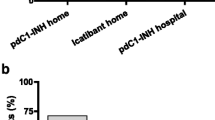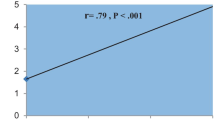Abstract
Introduction
Prodromal symptoms commonly precede hereditary angioedema (HAE) attacks. There is continuing interest in evaluating prodromes as treatment indicators, but a paucity of relevant data. This study was designed to prospectively identify prodomal characteristics in patients voluntarily reporting such information around the time of seeking treatment for an acute HAE attack.
Methods
Twenty-eight patients with HAE were enrolled in this survey, which was conducted in the context of an open-label study of treatment of HAE attacks with plasma-derived C1-inhibitor concentrate. At the time of treatment, patients were encouraged to answer survey questions about prodromal symptoms preceding that particular HAE attack.
Results
Twenty-one patients provided prodromal information for 253 treated HAE attacks. Seventy-one percent of patients (15/21) reported prodromes. Three patients accounted for approximately 80% of the attacks and 89% of the reported prodromal symptoms. Prodromes were experienced before 67.6% (171/253) of attacks, with a mean of 1.4 prodromes per attack. Fatigue was the most frequent prodrome (42% of attacks), followed by nausea (26%), and flu-like symptoms (22%). The median duration of a prodrome before an attack was 12 h (range, 0.33-24 h).
Conclusions
Despite many limitations in the study design, these findings confirm that prodromes are frequently associated with HAE attacks in many patients and occur sufficiently early to allow time for treatment initiation. The frequency of “false positive” prodromal symptoms remains undetermined, and the authors captured data only on attacks severe enough to warrant treatment. Additional well-designed prospective studies are clearly needed to continue investigating the potential clinical relevance of prodromes.
Similar content being viewed by others
References
Zuraw BL. Hereditary angioedema. N Engl J Med. 2008;359:1027–1036.
Bernstein JA. Hereditary angioedema: a current state-of-the-art review, VIII: current status of emerging therapies. Ann Allergy Asthma Immunol. 2008;100(Suppl. 2):S41–S46.
Bork K, Siedlecki K, Bosch S, et al. Asphyxiation by laryngeal edema in patients with hereditary angioedema. Mayo Clin Proc. 2000;75:349–354.
Prematta MJ, Kemp JG, Gibbs JG, et al. Frequency, timing, and type of prodromal symptoms associated with hereditary angioedema attacks. Allergy Asthma Proc. 2009;30:506–511.
Bowen T, Cicardi M, Bork K, et al. Hereditary angioedema: a current state-of-the-art review, VII: Canadian Hungarian 2007 international consensus algorithm for the diagnosis, therapy, and management of hereditary angioedema. Ann Allergy Asthma Immunol. 2008;100:S30–S40.
Craig TJ, Levy RJ, Wasserman RL, et al. Efficacy of human C1 esterase inhibitor concentrate compared with placebo in acute hereditary angioedema attacks. J Allergy Clin Immunol. 2009;124:801–808.
Cinryze (C1 esterase inhibitor [human]) [package insert]. Amsterdam, the Netherlands: Sanquin Blood Supply Foundation; November 2010.
Kalbitor (ecallantide) [package insert]. Cambridge, MA: Dyax Corp.; December 2009.
Firazyr (icatibant) [package insert]. Lexington, MA: Shire Orphan Therapies, Inc.; August 2011.
Kemp JG, Craig TJ. Variability of prodromal signs and symptoms associated with hereditary angioedema attacks: a literature review. Allergy Asthma Proc. 2009;30:493–499.
Beck P, Wills D, Davies GT, et al. A family study of hereditary angioneurotic oedema. Q J Med. 1973;166:317–339.
Cohen JD. Chronic familial giant urticaria. Ann Intern Med. 1961;54:331–335.
Donaldson VH, Rosen FS. Hereditary angioneurotic edema: A clinical survey. Pediatrics. 1966;37:1017–1027.
Farkas H, Harmat G, Fáy A, et al. Erythema marginatum preceding an oedematous attack of hereditary angioneurotic oedema. Acta Derm Venereol. 2001;81:376–377.
Nielsen EW, Gran JT, Straume B, et al. Hereditary angio-edema: new clinical observations and autoimmune screening, complement and kallikrein-kinin analyses. J Intern Med. 1996;239:119–130.
Ohela K. Hereditary angioneurotic oedema in Finland. Clinical, immunological and genealogical studies. Acta Med Scand. 1977;201:415–427.
Reshef A, Leibovich I, Kidon M. A survey of prodromal signs and symptoms of hereditary angioedema [abstract]. 6th C1 Inhibitor Deficiency Workshop; May 20–24, 2009; Budapest, Hungary.
Starr JC, Brasher GW. Erythema marginatum preceding hereditary angioedema. J Allergy Clin Immunol. 1974;53:352–355.
Williamson DM. Reticulate erythema — a prodrome in hereditary angio-oedema. Br J Dermatol. 1979;101:549–552.
Craig TJ, Bewtra AK, Bahna SL, et al. C1 esterase inhibitor concentrate in 1085 hereditary angioedema attacks — final results of the I.M.P.A.C.T.2 study. Allergy. 2011;66:1604–1611.
Wilson DA, Castaldo AJ, Vernon MK, et al. Effect of hereditary angioedema: health-related quality of life, depression, productivity, and social consequences [abstract]. J Allergy Clin Immunol. 2009;123(Suppl. 1):S142.
Huang S-W. Results of an on-line survey of patients with hereditary angioedema. Allergy Asthma Proc. 2004;25:127–131.
Longhurst HJ, Carr S, Khair K. C1-inhibitor concentrate home therapy for hereditary angioedema: a viable, effective treatment option. Clin Exp Immunol. 2006;147:11–17.
Bygum A, Andersen KE, Mikkelsen CS. Selfadministration of intravenous C1-inhibitor therapy for hereditary angioedema and associated quality of life benefits. Eur J Dermatol. 2009;19:147–151.
Author information
Authors and Affiliations
Corresponding author
Additional information
To view enhanced content go to www.advancesintherapy.com
Rights and permissions
About this article
Cite this article
Prematta, M.J., Bewtra, A.K., Levy, R.J. et al. Per-Attack Reporting of Prodromal Symptoms Concurrent with C1-Inhibitor Treatment of Hereditary Angioedema Attacks. Adv Therapy 29, 913–922 (2012). https://doi.org/10.1007/s12325-012-0053-5
Received:
Published:
Issue Date:
DOI: https://doi.org/10.1007/s12325-012-0053-5




